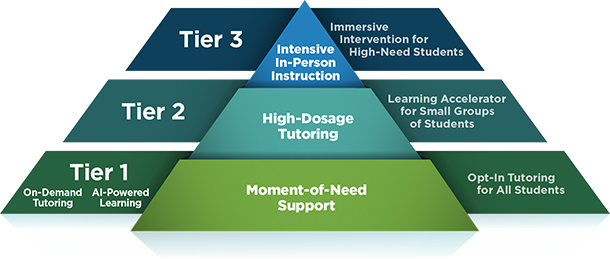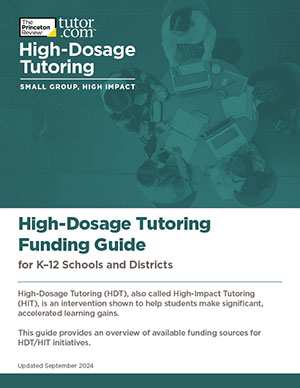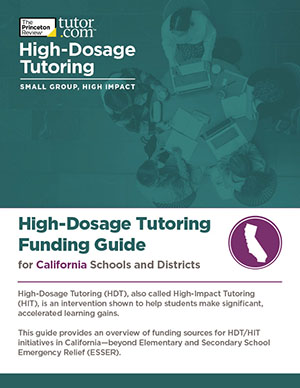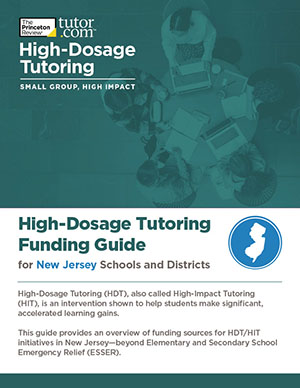About High-Dosage Tutoring
High-frequency, high-impact tutoring is a data-supported method of helping students make significant, measurable academic gains.
3+ times/week frequency
Tailored instruction aligned with state standards
Small-group instruction (up to 4 students)
Curriculum-driven, with high-quality materials
Assessment-based, with regular feedback
Consistent, relational learning
High-Dosage Tutoring Funding Guides
Learn more about High-Dosage Tutoring funding programs with our guides. Find your state below, or download the all-purpose guide for all states.
Video Library
Learn about our instructional design, teaching methodology, and more.
Multi-Tiered System of Supports
The diamond model illustrates the effectiveness of providing a suite of
academic support services to meet the wide-ranging needs of K–12 students.

How It Works
High-impact tutoring enables teachers to refer students who need intensive subject support, and then receive Lesson Reports three times per week to chart learner achievements.
-
Group of up to 4 students with similar needs is formed
-
Tutor creates Personalized Learning Plan for each student
-
Students meet with the same tutor during school hours, 3+ times per week
-
Tutor delivers tailored, interactive instruction and writes Lesson Reports after each session
-
Students complete periodic formative assessments to promote independent practice, support progress monitoring, and deliver reportable results
-
Teacher monitors topics covered, attendance, and student progress through the Teacher Dashboard
Curriculum
High-Dosage curricula are content-rich and aligned to priority standards for both Math and ELA. To ensure students are making significant learning gains, outcomes are a key program component.
Tutors consistently assess student progress through the use of formative assessments and scaffold the lessons as necessary to ensure learners are able to access grade-level content. Diagnostic and summative assessments additionally provide teachers and school leaders with visibility and insights into real-time and longitudinal student progress.
FAQ
Though the efficacy of high-impact tutoring has been documented for some time, the approach became central to many school districts’ response to learning loss amid the COVID-19 pandemic. The California School Boards Association concluded in 2021 that the model “drastically improves learning” in the context of COVID-related learning loss, while a University of Chicago study of more than 5,000 Chicago Public Schools ninth- and tenth-graders found that the intervention resulted in an additional 2.5 years’ worth of math instruction within a single academic year and substantially narrowed the socioeconomic access and achievement gaps that had widened during the pandemic.
A 2021 meta-analysis conducted by the Annenberg Institute of studies from across the United States showed that tutoring could “meaningfully increase learning for a wide variety of K–12 students.” Similarly, a 2017 study that evaluated the efficacy several comparably complex interventions—tutoring, progress monitoring, cooperative learning, computer-assisted instruction, and mentoring—found that tutoring had the greatest impact in measurable learning outcomes among socioeconomically disadvantaged populations.
High-impact tutoring is delivered online via LEO , our comprehensive proprietary academic support delivery platform. Research suggests that online delivery is just as effective as in-person sessions, and online delivery is often easier for students to schedule and participate in.
High-Dosage Tutoring is available in Algebra I, Middle School Math, Elementary Math, Elementary ELA, and Middle School ELA.
Each session will be 30–45 minutes in duration. Students will engage in sessions three or more times per week.
A maximum of four students participate in high-impact tutoring with a single instructor.
The critical difference is that high-impact tutoring is necessarily high-frequency (three times per week), subject-intensive (in a single area), curriculum-based, and pre-scheduled. In addition, high-impact tutoring is delivered to small groups of three or four students at once. On-demand tutoring, by contrast, is delivered as needed in a variety of subject areas , on a one-to-one basis.
Read more about the difference between high-impact and on-demand tutoring.










